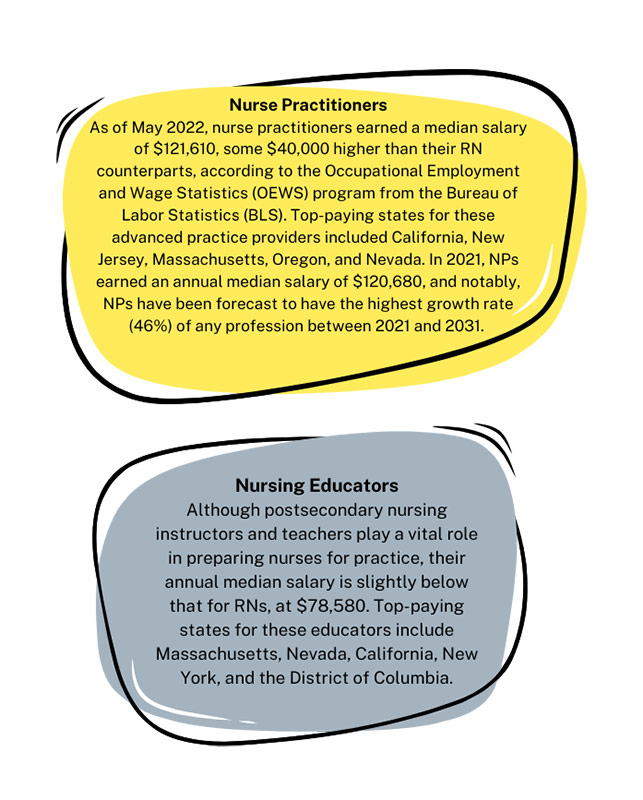If you’ve seen an increase in your paycheck in the past few years––and hopefully you have––you are part of an overall trend of increases in salaries for nurses. And, as you might expect, some of that has to do with the effects of the COVID pandemic.
“We’ve seen an increase in nursing salaries, particularly since the pandemic,” says Katie Boston-Leary, PhD, MBA, MHA, RN, NEA-BC, director of nursing programs and co-lead for Project Firstline at the American Nurses Association (ANA).
Registered Nurses (RNs) earned a median salary of $81,220 in May 2022, according to the Occupational Employment and Wage Statistics (OEWS) program from the Bureau of Labor Statistics (BLS). That’s up from a median salary of $77,600 in 2021. The mean (as opposed to median) annual wage for RNs as of May 2022 was $89,010.

Katie Boston-Leary, PhD, MBA, MHA, RN, NEA-BC, is the director of nursing programs and co-lead for Project Firstline at the American Nurses Association (ANA)
Nurses on the West Coast and Northeast generally enjoy higher salaries than nurses in other areas of the country, with an annual mean wage of $87,990 to $133,340. The top-paying states for RNs included California, Hawaii, Oregon, Massachusetts, and Alaska. The lowest salaries were clustered in the middle of the country, where the annual mean wage of $37,360 to $74,330 was indicated for nurses in states such as South Dakota, Missouri, Tennessee, and South Carolina.
Some 46% of surveyed nurses earned a salary between $80,000 and $139,999, according to the 2022 Nursing Trends and Salary Survey Results published in American Nurse, the official journal of the ANA. Those figures were up from 39% in 2021 and 41% in 2020. Nearly half (47%), notes the report, earn less than $80,000, but 62% reported that their salary was higher than the prior year.
Pandemic Effects
Before the pandemic, healthcare organizations were moving away from merit increases for nurses and shifting more toward bonuses and cost of living increases, according to Boston-Leary. But that has been problematic, she notes, because a great deal of data indicates that, to a certain degree, nurses live barely above livable wage in some markets. As a result, some nurses work overtime or take on second jobs.
The pandemic encouraged nurses to feel justified in asking for fair compensation. “It’s important to recognize also that, culturally, it has been taboo for nurses to raise the salary issue because the thinking around nursing has always been that it’s altruistic. It’s about serving others. It’s not about money. It’s true. Many of us didn’t get into nursing to get rich. But you hope you’ll get compensated appropriately, and it’s always been a struggle for nurses to advocate for what they deserve in terms of their salaries. So I think some of that broke through with the pandemic.”
Not only were nurses who were incumbents in organizations making less than the staff they were training, notes Boston-Leary, but also agency nurses were making a lot more than they were. “That created this untenable situation where many nurses rallied,” some striking or entering new bargaining agreements.
“Now we’re in this place where there’s a reckoning point, and there is some making up that’s happening,” says Boston-Leary.
Minority Challenges
Nurses of color face challenges when it comes to salaries. “The difference is that many nurses of color don’t get the opportunities to climb the career ladders as quickly as their white counterparts,” says Boston-Leary. “That in itself presents a salary discrepancy. And there are many more minoritized nurses with multiple degrees and academic achievements that are not in leadership roles compared to their white counterparts with lesser credentials.”
Organizations have had the reluctance to track such data as turnover for nurses of color and nurse satisfaction by race, notes Boston-Leary. “There’s been an unwillingness over the years to look at that because when you look at it, you must deal with it. That is starting to change, but we’re still not fully there.”
Sign up now to get your free digital subscription to Minority Nurse.
- Meeting Mental Health Needs - April 25, 2024
- Nursing Informatics: Connecting Tech with Care - March 22, 2024
- Practical Strategies for Implementing Evidence-Based Practice - February 22, 2024




